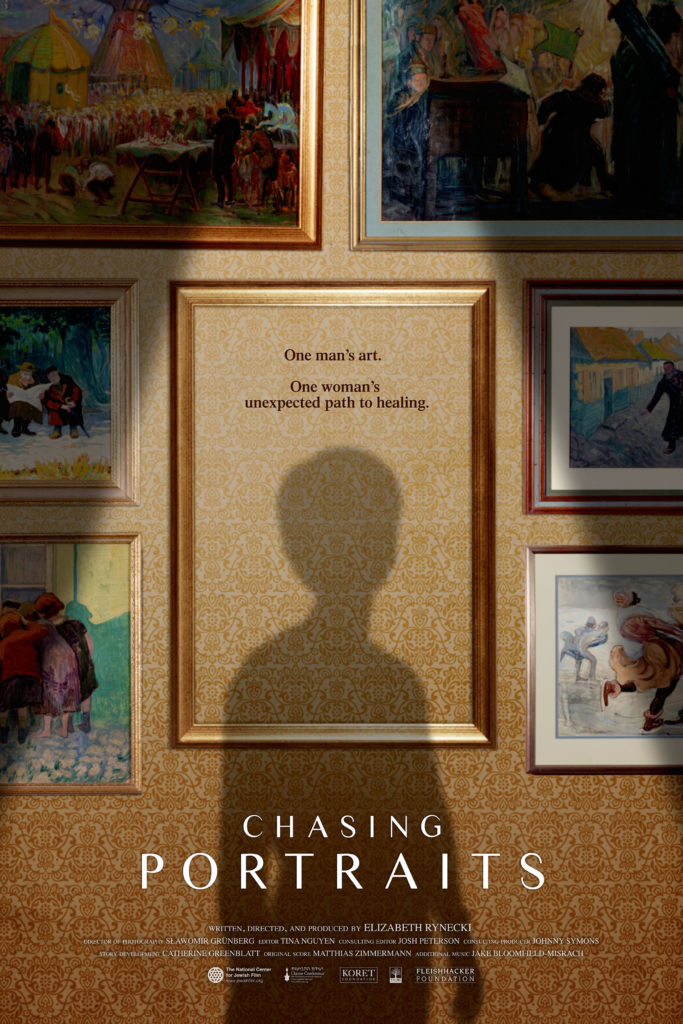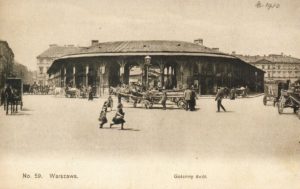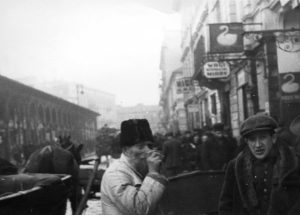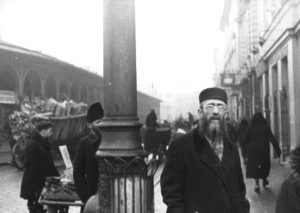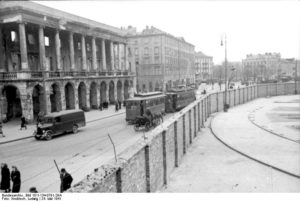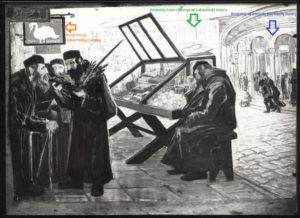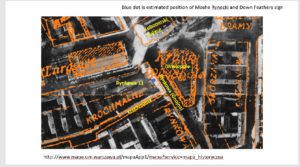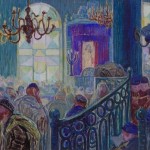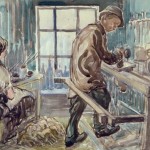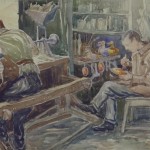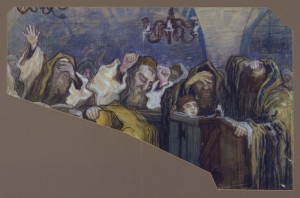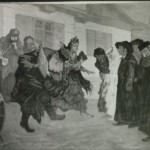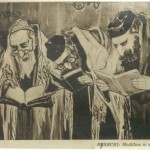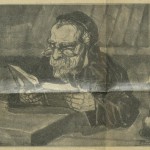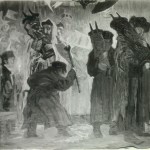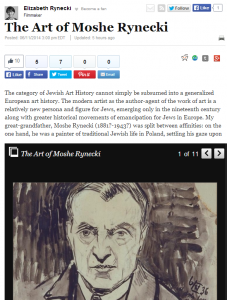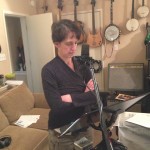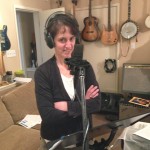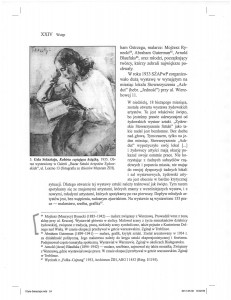CHASING PORTRAITS film poster
Pierze Puch – Down Feathers
In 1929 my great-grandfather, Moshe Rynecki (1881-1943), painted this painting in Warsaw, Poland. I know this because the painting (it’s untitled, but contains the image of the goose with the words, Pierze Puch, which means Down Feathers, thus the blog post title) is dated in the lower left hand corner along with the Polish spelling of the city: Warszawa. My family once had possession of this painting, but no longer knows its whereabouts.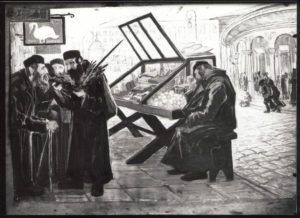
If you’re not entirely familiar with my family’s story, here’s the brief synopsis:
My great-grandfather was a prolific Warsaw based artist who painted scenes of the Polish Jewish community in the interwar years. In the early days of the Second World War he became concerned about his body of work and made the decision to divide his paintings, sketches, and notebooks into bundles, which he then hid with friends and acquaintances in and around the city of Warsaw. He then went into the Warsaw Ghetto and was eventually deported to Majdanek, the Nazi concentration and extermination camp, where he perished. My Dad (who was not quite 3 when the war started) and his parents survived the war on false papers. After the war, (please read Chasing Portraits to learn the longer story), Moshe’s widow recovered a small percentage of the hidden paintings. Trying to leave behind the destruction and horrible memories of the war, Dad and his parents moved to Italy. In Rome, they made photographs of a number of surviving paintings. This was one of the photographs that they made. Unfortunately, while we have this photo, my family no longer has the painting, and I don’t know who has it.
In 2008 I began work on a documentary film (currently in post-production) about my quest for my great-grandfather’s lost paintings, and produced a 9-minute “proof of concept” trailer. The trailer contains this photograph. This is important to explain because it’s not online elsewhere and I was recently contacted by Elly (Eliezer) Trepman (he’s researching information about the street where his father grew up), who spotted the image in the trailer and thought it was along the street he’s researching.
The painting seems to be slightly north of the Rynkowa-Krochmalna intersection. The building on the left, next to the men with the lulav (the closed frond of the date palm tree used during the Jewish holiday of Sukkot), is probably Rynkowa 11. The round building on the right with the arches, across the street, is probably the market building Wielopole (Gościnny Dwór).
Additionally, while the goose down icon (Pierze Puch) was probably fairly common in Poland, there were, in fact, two such signs on Rynkowa Street; a square one at Rynkowa 11 and a round one just two houses south, at Rynkowa 7. While these photographs from Yad Vashem’s digital collection were taken from the other side of the goose sign, facing south, they are along the same street.
Furthermore, it appears that the Rynecki painting also includes the front columns of Lubomirski Palace.
To help point out these features in the Rynecki painting, I’ve marked up this image (click on the photograph to enlarge it).
An aerial image with the various components discussed above, labeled here for purposes of better understanding the street geography.
I am, once again, reminded that I never know how, or when, or in what manner I will receive new clues about my great-grandfather’s life and body of work. My project is titled Chasing Portraits for many reasons, but one of the themes that seems to intrigue people the most is the idea of chasing down details and fragments of general history and of history specific to my family. I am grateful to all who provide clues and details that allow me to better understand my great-grandfather and his art. Thank you for being part of the journey.
#MuseumWeek
It’s #MuseumWeek 7 days, 7 themes, 7 hashtags. Today’s theme is#architectureMW and it is all about telling the story of a museum’s building, garden, neighborhood or other key locations for the institution. The goal is to introduce the museum from a different point of view. There is, unfortunately, no Moshe Rynecki museum, although his works are in museums in Poland (The Jewish Historical Institute and the National Museum in Warsaw), Israel (Yad Vashem), and the United States (The Magnes Collection of Jewish Art and Life). So I thought I’d riff on the theme a bit and offer images of my great-grandfather’s paintings that incorporate the architecture within the scenes he has painted. Architecture is, after all, also about how people use and interact with interior spaces.
We Expect Our Art to be Perfect
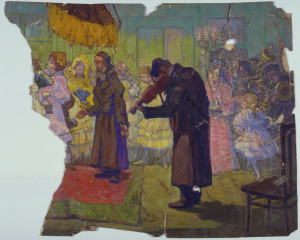 Are you on Facebook? So is Moshe Rynecki: Portrait of a Life! This recent Facebook post has elicited some nice comments, so I’m sharing it here too.
Are you on Facebook? So is Moshe Rynecki: Portrait of a Life! This recent Facebook post has elicited some nice comments, so I’m sharing it here too.
We expect our art to be perfect, unblemished. We are taught to say it is damaged or no longer as valuable when the artist’s original image is damaged. We lament imperfection. But in these tears and creases in my great-grandfather’s works I see a story to be told. These losses aren’t to be mourned. This is valuable history that speaks volumes of the Polish-Jewish community and the tragic losses it suffered in the Holocaust.
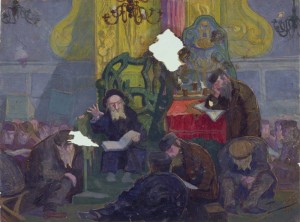
[Follow us on Facebook, Twitter, and Instagram]
A Story Across Generations
My search for my great-grandfather’s lost paintings is neither hopeless nor quixotic: I have found dozens of lost works, and have evidence that at least several dozen, and possibly hundreds, remain to be found. But it’s just not possible to find more of the lost art on any sort of timetable. Instead, there is a lot of waiting for something to happen. In between discoveries in my own search I sometimes am connected to other people’s wonderful quests. This post is about one of those stories.
As many readers know, in October 2013 I made the remarkable discovery of the Otto Schneid archive at the Thomas Fisher Rare Book Library at the University of Toronto. The archive has letters written by my great-grandfather and photographs of several of his paintings (the four presented here are from the archive). As a result of my learning about the Otto Schneid archive, I also connected to one of Schneid’s sons, Adam, and his wife, Chaia. In June I visited them in Canada and we had a lovely visit where we marveled at our finding one another and the history that links our two families. I think I kept saying, “imagine if Otto and Moshe could see us sitting here together in a restaurant…” and we all just shook our heads, all a bit shell shocked at our having found one another.
My connection with Adam and Chaia has now led me to another fabulous story. This one is not a Moshe Rynecki story, but it is a lovely and delightful one from Chaia’s cousin, Lil Blume, and her search for her grandmother’s lost story. All of Lil’s life she had heard her grandmother wrote articles and stories for Yiddish publications, but she’d never seen or read any. Eventually she went searching for one and discovered a tale of her great-grandfather’s antiquarian Jewish bookstore in Warsaw in the 1890s. The story is a historically important and charming glimpse into a lost world.
I very much enjoyed the story Lil’s grandmother wrote, but it is the stories behind the story that I particularly love about Lil’s tale. In her piece, Writing in the Family, Lil shares the path of her search and the people along the way who helped her. My favorite line in the piece is, “I sent an email to the library telling them about my search and received a response ten minutes later as if they had been waiting to hear from me.” This line gave me the chills. I’ve had very similar experiences and it always makes me wonder what else is out there that we just don’t know how to access.
As if Lil’s find of the story wasn’t enough, she has another marvelous story-behind-the-story which she shared with me in an email:
The story of finding my grandmother’s writing was published in an anthology called Living Legacies: A Collection of Writing by Contemporary Canadian Jewish Women, Volume II, ed. Liz Pearl, PK Press, 2010. I read my story at the launch and when I was done, a woman in the audience said “I knew your grandmother.”
I thought she was mistaken and that she must mean my mother, who is still active at 87.
“No,” the woman said, “I knew your grandmother. We used to visit your grandmother all the time when I was a child. This woman then named my aunt and uncles.
It turns out the woman was the daughter of the Canadian Yiddish poet YY Segal. Segal had been a great friend of my grandmother and took his young daughter with him when he visited. I talked with her after to see what I could learn about my family. She spoke of how poor my grandmother’s family were. She said, “The Halperns were poor. Everyone was poor. But the Halperns were more poor.”
I love stories like these. It is, as Lil wrote to me, “fascinating and grounding finding the creative works of our ancestors.” Indeed. Our searches continue.
The Art of Moshe Rynecki
“The Art of Moshe Rynecki” is the title of my latest Huffington Post piece. It includes a slideshow of my great-grandfather’s work, highlighting the various types of scenes he painted. You can read it on the Huffington Post’s Art and Culture pages:
Recording Voice Over for Collaborative Video Project
About a year ago I met Paige Dansinger on Twitter. Paige is a Minneapolis, Minnesota based artist who, among many things, uses her ipad to draw and paint pictures. Paige will tell you she’s just trying to engage people in art and use a playful manner to educate and excite, but Paige does more than draw on her ipad. Paige uses a program she developed called #DrawArt and when she uses it, you can actually watch her work. This means that you can observe her creativity and artistic process in action. It’s mesmerizing and so imagine my excitement when she suggested we do a project together!
This post is a little bit of a teaser because the joint #MRynecki and Paige Dansinger project is not quite finished. Last week I recorded a voice over narrative for the #DrawArt work Paige has created with several of my great-grandfather’s paintings and now that needs to be combined with the paintings Paige has completed and then finally uploaded for viewing. In the meantime, here are two photographs of me in a studio recording my voice over.
To learn more about Paige you can visit her website (she’s also on twitter: @museumpaige, Facebook, and Instagram).
You can also read this lovely article, Magic of Art with Paige Dansinger, that my friend Keri Douglas wrote about Paige on her own site, 9musesnews.com
44 Renowned Artists Featured in Warsaw Exhibition
I found an article (perhaps an excerpt from a book?) online, written in Polish, that includes information about my great-grandfather in a footnote. I asked Yagna Alston, a friend who is a PhD Candidate in the Institute of Jewish Studies at Jagiellonian University in Poland, for some translation assistance. I’m including an image of the one page here as well as a link to the online source (see page 14). The article/chapter is about the Polish artist, Gela Seksztajin (1907-1942). This excerpt is about exhibits featuring her work and who else showed at the same time.
There are a number of interesting and exciting things about this paragraph. For me, it’s particularly thrilling to know that a woman artist had her worked featured right alongside her [Read more…]
Rynecki and Vishniac on the Jews of Poland
I’ve frequently been asked, “Were Roman Vishniac and Moshe Rynecki aware of each other’s work?” I really have no idea, but they were contemporaries and the subjects and themes in the work of each artist are remarkably similar. I always like to say that my great-grandfather painted the same sorts of people and communities around the same time, if not slightly before, Vishniac photographed them.
Roman Vishniac was born in Russia in 1897 to wealthy and secular Jewish parents. The family eventually moved to Germany and then later to the United States. Vishniac is perhaps best known for photographing Jews in Central and Eastern Europe before the Holocaust. His book A Vanished World, published in 1983, is a detailed pictorial [Read more…]
Appreciating Jewish Art: A personal, family tale
Jewish Art Education is an organization “dedicated to bringing the best in the Jewish visual arts to the widest possible audience. Our mission is to educate the wider world on the contributions of the visual arts to Jewish civilization.” Earlier this year I was invited to write a guest blog for them about the Moshe Rynecki project. I did that in a piece titled, “A Window to the Past.”
More recently I was asked to write a piece about the importance and value of teaching, studying, and appreciating Jewish art. My new piece is now on their site, or you can read it here:
Appreciating Jewish Art: A personal, family tale
(Guest blog written for Jewish Art Education site. July 2013)
On my desk is a photograph of a self-portrait of my great-grandfather, dated 1931. I’ve propped it up next to my screen so that when I take a break from typing and look over at it, he’s looking back at me. When I look at him, I imagine him asking, “What are you doing?” It’s a question I frequently ask myself; the answer sometimes eludes me. [Read more…]
